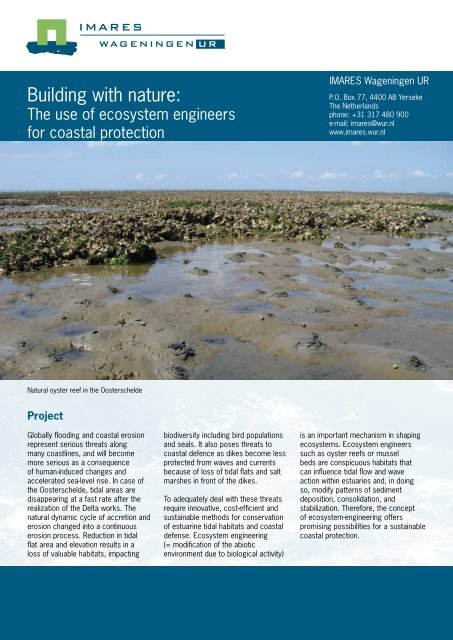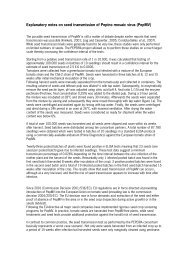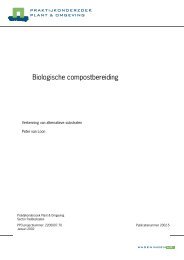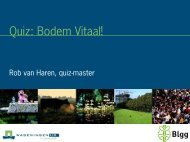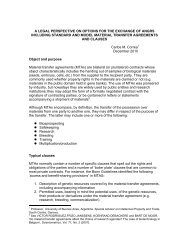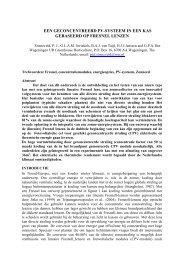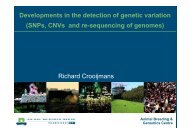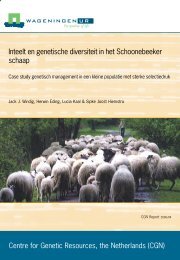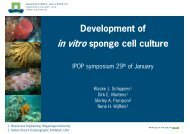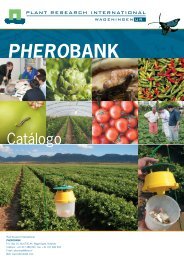Building with nature: - Wageningen UR
Building with nature: - Wageningen UR
Building with nature: - Wageningen UR
You also want an ePaper? Increase the reach of your titles
YUMPU automatically turns print PDFs into web optimized ePapers that Google loves.
<strong>Building</strong> <strong>with</strong> <strong>nature</strong>:<br />
The use of ecosystem engineers<br />
for coastal protection<br />
IMARES <strong>Wageningen</strong> <strong>UR</strong><br />
P.O. Box 77, 4400 AB Yerseke<br />
The Netherlands<br />
phone: +31 317 480 900<br />
e-mail: imares@wur.nl<br />
www.imares.wur.nl<br />
Natural oyster reef in the Oosterschelde<br />
Project<br />
Globally flooding and coastal erosion<br />
represent serious threats along<br />
many coastlines, and will become<br />
more serious as a consequence<br />
of human-induced changes and<br />
accelerated sea-level rise. In case of<br />
the Oosterschelde, tidal areas are<br />
disappearing at a fast rate after the<br />
realization of the Delta works. The<br />
natural dynamic cycle of accretion and<br />
erosion changed into a continuous<br />
erosion process. Reduction in tidal<br />
flat area and elevation results in a<br />
loss of valuable habitats, impacting<br />
biodiversity including bird populations<br />
and seals. It also poses threats to<br />
coastal defence as dikes become less<br />
protected from waves and currents<br />
because of loss of tidal flats and salt<br />
marshes in front of the dikes.<br />
To adequately deal <strong>with</strong> these threats<br />
require innovative, cost-efficient and<br />
sustainable methods for conservation<br />
of estuarine tidal habitats and coastal<br />
defense. Ecosystem engineering<br />
(= modification of the abiotic<br />
environment due to biological activity)<br />
is an important mechanism in shaping<br />
ecosystems. Ecosystem engineers<br />
such as oyster reefs or mussel<br />
beds are conspicuous habitats that<br />
can influence tidal flow and wave<br />
action <strong>with</strong>in estuaries and, in doing<br />
so, modify patterns of sediment<br />
deposition, consolidation, and<br />
stabilization. Therefore, the concept<br />
of ecosystem-engineering offers<br />
promising possibilities for a sustainable<br />
coastal protection.
goal<br />
This research project uses the<br />
concept of ecosystem engineering<br />
to investigate the potential use of<br />
biogenic reefs in the lower intertidal<br />
zone for consolidation and stabilization<br />
of tidal flats in the Oosterschelde.<br />
The project will provide the means to<br />
evaluate the effectiveness and impacts<br />
of an innovative and sustainable<br />
approach to reduce erosion of<br />
intertidal areas.<br />
approach<br />
We will set up field experiments at a<br />
scale that allows us to really monitor<br />
the effectiveness and impact of<br />
biogenic reefs for the stabilization of<br />
tidal flats and for their (local-scale)<br />
ecomorphological impact.<br />
For this purpose we follow different<br />
steps that allow us to successfully<br />
design such pilot experiments:<br />
• initial conditions for settlement<br />
and development of oyster reefs<br />
(habitat analysis);<br />
• development of suitable substrates<br />
(e.g. shells of mussels/oysters)<br />
for creating optimal conditions for<br />
biogenic reef development in tidal<br />
areas;<br />
• large-scale pilot to investigate<br />
possibilities to create biogenic reefs<br />
in the Oosterschelde and evaluate<br />
their effectiveness for consolidation<br />
and stabilization of tidal flats;<br />
• monitor pilot sites to determine their<br />
effect on the environment (physical,<br />
biological);<br />
• develop (predictive) tools/models to<br />
evaluate the use of biogenic reefs.<br />
To realize this project a multidisciplinary<br />
project team is set up <strong>with</strong><br />
scientists from IMARES <strong>Wageningen</strong><br />
<strong>UR</strong>, Deltares, NIOO and Van Oord.<br />
Testing of artificial substrates in the Oosterschelde<br />
results<br />
The project is now in its start up<br />
phase. A Habitat Suitability Index model<br />
(developed in cooperation <strong>with</strong> the<br />
project “WINN Biobouwers”) is available<br />
that uses key environmental variables<br />
to predict the habitat suitability for<br />
Pacific Oysters Crassostrea gigas in<br />
the Oosterschelde. Testing of artificial<br />
substrates at a small scale for oyster<br />
settlement is running (see photo) and<br />
a first pilot experiment at the slikken<br />
of Viaenen is foreseen in the spring of<br />
2009. A large-scale pilot will then be<br />
executed in 2010.<br />
Funding & funded by:<br />
follow up<br />
The ecosystem engineer concept<br />
offers promising opportunities for<br />
ecodynamic design, but has yet to<br />
be formally and explicitly applied.<br />
Identifying and managing probable<br />
engineering species and responsive<br />
ecosystems should be a key priority<br />
for a sustainable conservation and<br />
management and this will necessitate a<br />
shift to a process based understanding<br />
of the functioning of whole systems,<br />
which is a large and important<br />
step toward ecosystem-based<br />
management. This pilot experiment<br />
will enhance our understanding about<br />
the use of ecosystem engineers in this<br />
ecodynamic design.<br />
This project is part of the innovation program ‘<strong>Building</strong> <strong>with</strong> Nature’,<br />
managed and administered by the foundation EcoShape.<br />
The program aims at developing new design concepts for the layout<br />
and sustainable exploitation of river, coastal and delta areas.<br />
Information:<br />
www.ecoshape.nl<br />
Tom Ysebaert<br />
Anneke Hibma<br />
Tel.: +31 317 487 419 Tel.: +31 10 447 8190<br />
E-mail: tom.ysebaert@wur.nl<br />
E-mail: ahi@VanOord.com


